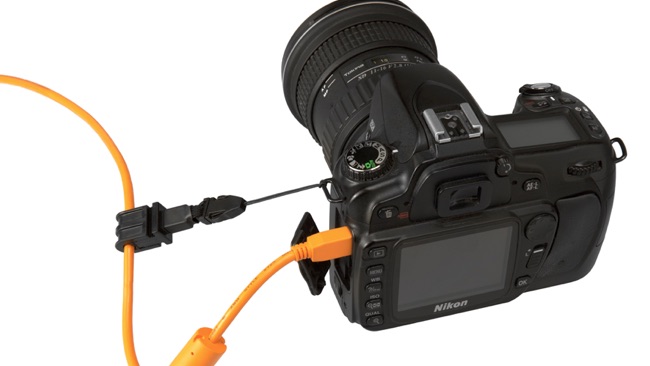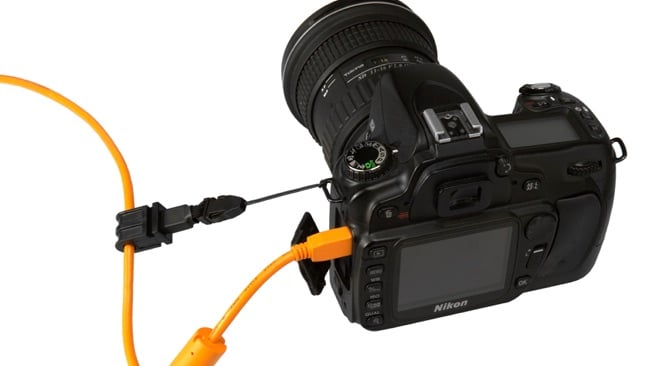
 Screenshot Tether Tools
Screenshot Tether Tools
Shooting tethered gives you the ability to see more detail on a larger monitor, not to mention the ability to control the camera from the computer itself. If you want to give it a go, here are some things think about.
Shooting tethered can also serve merely as a way to give your client something to view as it happens. With today’s cameras pushing so many megapixels and such high resolutions, much of that is lost on a tiny 3.4in LCD screen. By shooting tethered, you have the ability to see more detail because of the larger monitor to review from. Another benefit of shooting tethered is that you can control your camera from the computer itself.
Who shoots tethered? Portrait photographers, mostly. Shooting tethered has been the domain of professionals in the studio for years because they have digital assistants who can manage the image data, even colour-correcting in real-time as you go. But today, even the most basic camera supports tethering and many beginning and intermediate shooters are starting to experiment with it. Should you shoot tethered? Well, not everyone should. Those who shoot with a lot of mobility, like sports photographers, will find shooting tethered unpractical. But if you’re shooting in a studio or in places where you’ve got the camera locked down, like shooting astral photography, shooting tethered can be beneficial.
So, if you decide to shoot tethered, what do you need? Four things, according to professional photographer Joe Edelman. Edelman has a pretty great and informative YouTube channel and he says that to get the best results, you need a camera that supports tethering, a laptop or computer, the software, and a USB-chord that supports your camera’s data port. Cables are where things get interesting. Some use a right-angle cable, while others stick with the tried and true. The USB-cables can be daisy-chained together and you can put up to four back-to-back for up to 80 feet before data drop-outs become an issue.
But the real issue here and the danger of shooting tethered is that you have a wire attached to your camera. That wire can be pulled out suddenly — if your legs get tangled in the wire — and the camera data port could become damaged and trust me, the repair is nearly as costly as replacing the camera itself. This has lead to many shooters buying expensive blocks that attach to the camera to keep the cable loose at the plug but securely attached to the body. Some go the low-tech route and just use a rubber band. But the problem is that some camera data port designs are shallow, the plug failing to properly seat for the photographer to move around with the camera. It works fine for a camera locked down, but when you start moving, things can get dicey.
Why not use wireless? Well, WiFi is still relatively new as a built-in feature of DSLRs and medium format cameras, and as such, the speeds are way too slow compared to shooting wired. So you still have to use a tethered cable to shoot. It’s far faster than saving via WiFi and it helps to be able to review your images from a larger screen, thereby fine-tuning your image quality as you go.
Cable locks like the Tether Tools Tether Block are good. Created by professional photographer David Blattel after he suffered data port damage on his Nikon, this tether accessory allows you to adhere the block to your camera, preventing the cable from popping out. It screws into your 1/4-20 plug and has various sized channels for the cables you’re using. You weave your cable into the channels and it protects your data port from damage due to an accidental pull on the cable. It can also attach to a tripod head. Cost is just under $100, which seems a bit pricey. I bet there’s a 3D printed option that would work just as well.
The point is, you need to protect your data port at all costs if you decide to shoot tethered.
Lastly, there’s the software that supports tethering. From Adobe Lightroom and the various plugins for each specific camera to Canon’s EOS Utility and Phase One’s Capture One Pro (which has the additional benefit of being able to wirelessly stream images to a client’s smartphone or tablet), the proper software not only allows you to tether, but also control your camera remotely. There’s a comprehensive list of tethering utilities at https://www.tethertools.com/plugging-in/software/.
Bottom line here is that tethering has a specific purpose. It has its benefits and its liabilities. If you decide to try it, make sure you keep the safety of your equipment on par with your desire to get the best results. Use the right gear and you can have the best of both worlds, great images and the ability to review and write them to another source. It makes you look like the pro you want to be.
Tags: Production



Comments